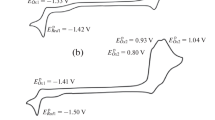The possibility of target control of the electro-optical properties of polymethacrylate with covalently bound azobenzene chromophores in a side chain by introducing metal ions capable of chromophore coordination, acceptor substituents that change the dipole moment of an azobenzene fragment, and organic dyes that expand the range of light absorption of azobenzene chromophore were considered. The mechanism of action of these factors was analyzed.




Similar content being viewed by others
References
Y. Zhao and I. Tomiki (Eds.), Smart Light-Responsive Materials . Azobenzene-Containing Polymers and Liquid Crystals, Wiley & Sons, NJ (2009).
P. Che, Ya. He, X. Wang, and P. Che, Macromolecules, 38, 8657-8663 (2005), doi:https://doi.org/10.1021/ma0511393.
H. Rau, Photoreactive Organic Thin Films, in: Z. Sekkat and W. Knoll (Eds.), Academic Press, San Diego (2002), pp. 3-47, https://doi.org/10.1016/B978-012635490-4/50002-0.
N. Davidenko and I. Davidenko, Photosensitive Polymeric Composites for Information Technologies, Cambridge Scholar Publishing, Cambridge (2019).
N. A. Davidenko, I. I. Davidenko, I. A. Savchenko, et al., J. Appl. Phys., 103, 094323 (2008), https://doi.org/10.1063/1.2913315.
I. I. Davidenko, I. A. Savchenko, A. N. Popenaka, et al., Ferroelectrics, 352, 158-163 (2007), doi:https://doi.org/10.1080/00150190701358274.
I. I. Davidenko, Opt. Mater., 34, 679-684 (2012), https://doi.org/10.1016/j.optmat.2011.10.00.
Nikolay A. Davidenko, Irina I. Davidenko, and Alexander A. Ishchenko, Spin-Dependent Processes in Information Media Based on Photoconductive Polymer Composites, Taras Shevchenko National University of Kyiv, Kyiv (2020).
L. Nikolova and P. S. Ramanujam, Polarization Holography, Cambridge University Press, Cambridge (2009), https://doi.org/10.1017/CBO9780511581489.
I. Savchenko, N. Davidenko, I. Davidenko, et al., Mol. Cryst. Liq. Cryst., 468, No. 1, 203I[555]-213I[565] (2007), https://doi.org/10.1080/15421400701230014.
A. V. Kulinich, N. A. Derevyanko, and A. A. Ishchenko, J. Photochem. Photobiol. A, 188, 207-217 (2007), https://doi.org/10.1016/j.jphotochem.2006.12.014.
S. L. Bondarev, S. A. Tikhomirov, V. N. Knyukshto, et al., J. Lumin., 124, 178-186 (2007), https://doi.org/10.1016/j.jlumin.2006.07.001.
A. A. Ishchenko, A. V. Kulinich, S. L. Bondarev, and V. N. Knyukshto, Opt. Spectrosc., 104, 57-68 (2008), https://doi.org/10.1007/s11449-008-1008-y.
Andrii V. Kulinich, Nadia A. Derevyanko, Elena K. Mikitenko, and Alexander A. Ishchenko, J. Phys. Org. Chem., 24, 732-742 (2011), 10.10.02/poc.1821.
Nadezhda A. Derevyanko, Alexander A. Ishchenko, and Andrii V. Kulinich, Phys. Chem. Chem. Phys., 24, 2748-2762 (2020), 10.10.39/C9CP05827C.
Author information
Authors and Affiliations
Corresponding author
Additional information
Translated from Teoretychna ta Eksperymentalna Khimiya, Vol. 57, No. 5, pp. 279-283, September-October, 2021.
Rights and permissions
About this article
Cite this article
Davidenko, I.I., Ishchenko, A.A., Kravchenko, V.V. et al. Electro-Optical Properties of Polymethacrylate with a Covalently Bound Azo Chromophore. Theor Exp Chem 57, 325–330 (2021). https://doi.org/10.1007/s11237-021-09701-6
Received:
Accepted:
Published:
Issue Date:
DOI: https://doi.org/10.1007/s11237-021-09701-6




